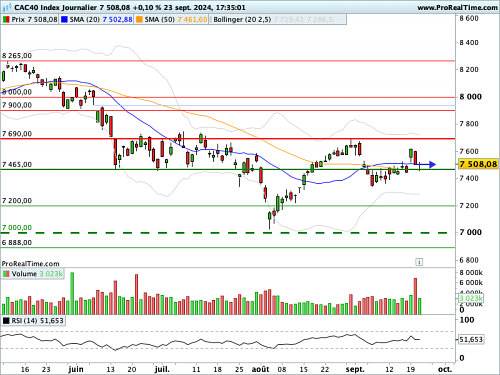(News Bulletin 247) – This article, freely accessible, is produced by the News Bulletin 247 stock market analysis and strategy research team. To not miss any opportunity, consult the full analyses and discover our portfolios by accessing our Privileges area.
The Paris Stock Exchange was completely calm on Monday, after two sessions of high volatility following the Fed’s decision, which “temporized” in the immediate vicinity of a major graphic threshold for its flagship index, the CAC 40 (+0.10% at 7,508 points).
As a reminder, the Fed decided on Wednesday, after two days of meetings, to “strike hard” by lowering the key rate by 50 basis points in one go, thus vigorously initiating the monetary easing process. This is not a surprise, in the sense that the market was in any case divided between a scenario of -25 and another of -50 basis points.
The decision was accompanied by new economic projections: the powerful monetary institution headed by J Powell revised upwards its unemployment forecast to 4.4% for the current year and the next, and downwards its inflation forecast for 2025 to 2.1%.
The “dot plots”, that is to say the economic and monetary projections of the members of the Fed, showed that the central bankers anticipated, at the median level, another 50 basis points of rate cuts this year, when the market, itself, rather counts on 75 basis points.
“Jerome Powell is determined to do everything he can to ensure a soft landing and is showing little willingness to accept a further deterioration in the labour market,” explains César Perez Ruiz, Chief Investment Officer and CIO at Pictet Wealth Management. “With the Fed Funds rate still well above the FOMC’s neutral level, we expect another 50bp rate cut in November, followed by a 25bp reduction in December,” the asset management decision-maker continued.
Banks weighed on the trend, like its main representatives on the Paris market, Société Générale (-2.81%), BNP-Paribas (-3.66%) and Crédit Agricole (-4.46%). And this in reaction to the gloomy figures concerning the activity of the private sector in the euro zone and the uncertainties surrounding the plans of the new government of French Prime Minister, Michel Barnier, aimed at taxing the richest.
In the statistical chapter, deprived of a sharp macroeconomic benchmark on Friday, operators made up for it on Monday with the preliminary data of the PMI activity indicators in the Eurozone, which missed all their expectations, with a “red card” for German industry, at 40.3 points. Let us recall that a score below 50 signifies a contraction in the sector considered. On the scale of the entire monetary union, the industrial score for the current month is 44.8 (consensus at 45.7) and the services score 50.5 (consensus of 52.3).
Dr. Cyrus de la Rubia, Chief Economist at Hamburg Commercial Bank, commented: “The fragility of the industrial economy is reflected in the level of employment, with manufacturing employment recording its sharpest decline since August 2020. At the same time, employment growth slowed for a fourth consecutive month in the services sector, and was close to stagnation. Official employment figures, which have remained stable so far, are likely to deteriorate in the coming months, but probably less sharply than in previous recessions, thanks to current demographic trends.”
On the other side of the Atlantic, the main stock indices ended Monday’s session close to equilibrium, symbolically in the green, like the Dow Jones (+0.15%) and the Nasdaq Composite (+0.14%). The S&P500, the benchmark barometer of risk appetite in the eyes of fund managers, gained 0.28% to 5,718 points.
An update on other risky asset classes: around 8:00 this morning on the foreign exchange market, the single currency was trading at a level close to $1,1110. The barrel of WTI, one of the barometers of risk appetite on financial markets, was trading around $71.10.
On the agenda this Tuesday, to follow as a priority the IFO index of the business climate in Germany at 10:00 a.m., and for the United States, the S&P Cs index of real estate prices in 20 representative agglomerations at 3:00 p.m., the consumer confidence index (Conference Board) and the manufacturing index of the Richmond Fed at 4:00 p.m.
KEY GRAPHIC ELEMENTS
The key short-term chart levels were precisely hit: Friday, August 30 at 7,645 points, followed by a failure; and Wednesday, September 4 at 7,482 points, a handful of points from the 7,465 points below which a new bearish leg would form. This last level experienced a first alert on Thursday, September 5.
The fact that the leading French index ended at the lowest level of week 36, just after breaking the threshold, is decisive. It sends a message of short-term weakness.
The key threshold to watch is 7,465 points, below which the opinion will remain negative.
Above, breathing is assured up to 7,690 points. Below, the resumption of bearish tensions is to be feared. Between the two (preferred scenario) erratic oscillations are envisaged.
FORECAST
Considering the key graphic factors that we have identified, our opinion is neutral on the CAC 40 index in the short term.
It should be noted that a crossing of 7690.00 points would revive buying tension. While a break of 7465.00 points would revive selling pressure.
The News Bulletin 247 council
Hourly data chart
Daily Data Chart

I have over 8 years of experience working in the news industry. I have worked as a reporter, editor, and now managing editor at 247 News Agency. I am responsible for the day-to-day operations of the news website and overseeing all of the content that is published. I also write a column for the website, covering mostly market news.










